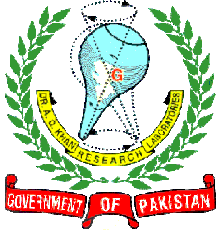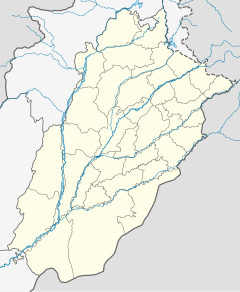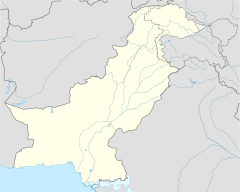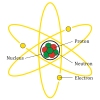 | |
| Former name | See note |
|---|---|
| Established | 31 July 1976 (1976-07-31) |
| Field of research | National security Fundamental science |
| Location | Kahuta in Rawalpindi, Punjab, Pakistan 33°37′16″N 73°22′41″E / 33.621106°N 73.3781°E / 33.621106; 73.3781 |
| Affiliations | |
| Operating agency | National Command Authority |
| Website | krl.com.pk |
| Map | |
  | |
The Dr. A. Q. Khan Research Laboratories (shortened as KRL), is a federally funded research and development laboratory located in Kahuta at a short distance from Rawalpindi in Punjab, Pakistan. Established in 1976, the laboratory is best known for its central role in Pakistan's nuclear weapons program and its understanding the nuclear science.
Established in 1976, it was originally organized as a top-secret plant dedicated to enrichment as a response to the India's detonation of its first nuclear bomb in 1974. Chosen for its remote yet relatively accessible location from Rawalpindi. In the 1970s, the site was the cornerstone of the first stage of Pakistan's atomic bomb program, and serves as the center for conducting the nuclear scientific research.
It is globally known for its research in gas centrifuges to produce the enriched uranium; and in past, it has competed with the PINSTECH on wide variety of weapon designs but it is now have focused in civilian missions, including the national security, fusion science and supercomputing.
History
Main article: Kahuta ProjectAs an aftermath of the India's first nuclear test, the Pakistan Atomic Energy Commission (PAEC) launched the studies on isotope separation through gas method by setting the plant as Project-706 under Bashiruddin Mahmood, a nuclear engineer, in 1974.
In 1976, the difficulties encountered in preliminary studies under Mahmood on understanding the equation of state of uranium indicated the need for a dedicated laboratory solely to that purpose. Work on establishing the laboratory was initiated by the army's Engineer-in-Chief who selected Brigadier Zahid Ali Akbar to conduct the topographic survey. Because the experiments were deemed too dangerous to conduct in a major city, the need for the operations to be moved in an isolated and remote mountainous areas was felt by Brig. Akbar who selected Kahuta, at a short distance of the Rawalpindi.
On 31 July 1976, the laboratory was established as Engineering Research Laboratories (ERL) with Abdul Qadeer Khan as its principal investigator. The officers and personnel from the Corps of Electrical and Mechanical Engineering (EME) were central in working and supporting the operations of the lab with Major-General Ali Nawab acting its principle engineer in 1979. More broadly, the ERL was intended to spur innovation and provide competition to the weapon design with the second lab in Nilore running under the PAEC's contract. Under Abdul Qadeer Khan, the work on equation of state of uranium began with drs. G. D. Alam, Tasneem Shah, and Anwar Ali who served as co-principle investigators at Kahuta.
Initially, a large numbers of centrifuges were deployed but they were scaled down to few centrifuges after revised critical mass calculations on equation of state of uranium by Abdul Qadeer Khan and his co-investigators in 1980s.
Its official name changed to Khan Research Laboratory (KRL) in 1981 by Presidential decree, which also allowed its status as a national defense laboratory.
Uranium research
Globally, the KRL has a prestige in conducting research into properties and behavior of uranium to learn how uranium is scaled to industrial-to-weapon-grade level and how its equation of state changes under the extreme pressure and temperature. For such investigation, principle investigators employed the Zippe method (local designation: Khan Centrifuge) that runs about 100,000 rpm on continuous at an average of 10 years.
The Uranium (U) is a naturally occurring element that can be found in low levels within all rock, soil, and water. The Natural uranium (U) consists of three isotopes, Uranium-238 (U), which is 99.28% natural abundance, the Uranium-235 (U), which is subject of interest for energy measurement available only at 0.71%, and uranium-234, with proportion of 0.0054%. The Uranium-235 is fissile but at 0.71% it cannot sustain the chain reaction in a nuclear weapon environment, which requires the 90% of U but remains uncontrolled whose reaction takes place in a short amount of time– in a nanosecond time. For this purposes, the gas centrifuge methods using the vacuum technology were established but this method took several years to master, and it was not until the 1985 when the highly enriched uranium (HEU) was first made available.
The computer simulations and experiments on uranium are conducted by KRL to understand the structural, electrical, material, and chemical properties as well as uranium fused allows and to determine how these materials change over time under temperature and pressure difference.
Negative publicity
The laboratory has attracted negative publicity from a number of events, mainly due to its past research affiliation with North Korea and China. In 1996, the Clinton administration accused China of approving the tender released for the KRL on the acquisition of specially-made magnetic rings for special suspension bearings mounted at the top of rotating centrifuge cylinders. In 1999, a visit by the Saudi dignitaries accompanied by the Sharif administration personnel to the laboratory also garnered further negative publicity at the Western media that raised fears of proliferation in the middle east.
In 2003, the Pakistani nuclear physicist, Abdul Qadeer Khan, was accused of (and later pardoned) for mishandling the classified information on the designs of the gas centrifuges to Libya, North Korea, Iran, and China in 1980s that were taken from the lab's computers.
Extended research
Main articles: Government College University, Lahore and Karachi UniversityThe academic research programs and development opportunities at the KRL are supported by the physics departments of the Government College University in Lahore in Punjab and the University of Karachi in Sindh. The KRL supports its physics program through funding and providing scholarship to physics and engineering students at the Government College University.
The continuing efforts to make the laboratories more science efficient led the Ministry of Science (MoST) to grant a three research and fellowship programmes with the Government College University with the support of Pakistan Science Foundation (PSF). Since 1980 at present, the KRL continues to develop the research work on computational mathematics, supercomputing and advanced mathematics to the extended applications to natural sciences.
In 1999, the KRL established a research institute on computer science at Kahuta, which was later integrated to University of Engineering and Technology in Taxila.
The civilian research on biotechnology, biology and Genetic Engineering is supported by the KRL at the University of Karachi, with the support from Pakistan Science Foundation. The KRL organized a conference on Computational biology in Islamabad to present overview of the scope of computational sciences.
National security and science program
From 1976 till 1978, the lab depended heavily on the Urenco Group's method on developing the gas centrifuge, which it says to be suffering due to incomplete mechanical parts and differential equation problems involving rotational dynamics on a fixed axis. Dependence on the Zippe-type was lessened when more effective and innovative methods were developed that culminated from the studies conducted under Drs. A.Q. Khan, G.D. Allam and T. S. Shah. In Pakistan MoD laboratory system, the KRL is a senior laboratory executes missions relating to national security.
The technology of krytron was also built at the KRL which was then transferred to Heavy Industries Taxila, an army laboratory based in Taxila. Besides the understanding the equation of state of uranium, the KRL also embarked on pioneering work on vacuum science and its extended application in plasma physics– its first paper on plasma physics was written in 1998. In 1983, the KRL was able to acquire its very first computer numerical control (CNC) from China to provide machining of the high-strength ultracentrifuges which was able to produce the uranium hexafluoride (UF6) gas that the KRL reduced to uranium metal and machined into weapon pits. In 1987, the KRL began publishing a series of academic articles on numerics and computational methods for centrifuge design, including a 1987 article co-authored by Abdul Qadeer Khan on techniques for balancing sophisticated ultracentrifuge rotors.
In the 1990s, the mathematicians at the KRL had built the nation's first high performance computing machines and the supercomputer that were installed installed at the facility. The subcritical experiments on weapon-grade uranium began when a parallel Computational Fluid Dynamics (CFD) division was established which specialized in conducting high performance computations on shock waves in weapons effect from the outer surface to the inner core by using difficult differential equations of the state of the materials used in the bomb under high pressure.
The KRL was major participant in MoD's Hatf program (lit. Target). The lab served as a chief designer of the warhead design, control systems, and rocket engine development of the Hatf and Ghauri weapon systems.
- Hatf-I – first tested in 1989.
- Ghauri-I (Hatf V) – first tested in 1999.
- Ghauri-II – has a range of 2,000–2,500 km.
Since the 1980s, the KRL is involved in numerous military equipment and conventional weaponry development projects. The resulting systems have been put into service by the Pakistan's military and exported to other friendly nations. The following is a list of known equipment produced under these projects:
- Guided missiles:
- Anza series MANPADS.
- Baktar-Shikan man-portable anti-tank guided missile (ATGM).
- Modules for the BGM-71 TOW ATGM.
- Electrical and electronic equipment:
- Power conditioners for the above missile systems.
- Switched-mode power supplies for the following air defence systems:
- LAADS radar, Skyguard radar, Air Defense Automation System.
- Equipment for clearance of anti-personnel and anti-tank mines, including remote control mine exploders (RCME) and mine-sweeping line charges.
- Laser equipment:
- Laser range-finders, laser warning receivers, laser aiming devices, a laser actuated targeting system for training tank gunners.
- Reactive armour kits for armoured vehicles and APFS-DS anti-tank ammunition for main battle tanks.
- Digital goniometers.
- Electronic Voting Machine (EVM)– the KRL entered in competition with National Institute of Electronics (NIE) and Indra Sistemas of Spain to produce and demonstrate the usage of electronic voting machines. Eventually, the Election Commission of Pakistan awarded the contract to KRL for the final design and production of the electronic voting machines in 2018.
Corporate management
Contract changes
The KRL is owned by the federal Government of Pakistan and sponsors the laboratory through the Ministry of Defence as its continuing efforts to make the laboratory more efficient. In its early years, the Corps of Engineers had served its first prime contractor from 1976 until 1977. From 1977 till 1981, the Corps of Electrical and Mechanical Engineering served on the MoD's contract with Maj-Gen. Ali Nawab overseeing the lab's operations. Since then, the lab's corporate leadership has been entrusted with civilian leadership through contracts awarded by the MoD.
At the behest of the laboratory director in 1981, the tender was opened to the University of Karachi and the Government College University to oversee its operations. The KRL's research and university affiliation with the University of Karachi still continues to this date.
With the formation of the federal National Command Authority in 2001, the agency took over the lab's business operations when it awarded the Strategic Plans Division as KRL's prime contractor, which it has been managing the lab operation since 2004.
In 2010, the Strategic Plans Division won its first contract with Malaysian Armed Forces when it was reported that the KRL was to a contractor for weapons export through the Malaysian businessman Shah Hakim Zain to export weapons to Malaysia.
Notes
- Previously known at various times as Project-706 from 1974–76 by PAEC and later as the Engineering Research Laboratories (1976–81). It was also known as Khan Lab by U.S. Government in 2003 and Kahuta Research Laboratories (2004–08)
References
- Aziz, Shaikh (26 July 2015). "A leaf from history: Defending Kahuta". DAWN.COM.
- Originally, the concept was conceived during the post-1971 war, and the programme was launched in 1974 under the codename "Project-706". In 1976, the laboratories was founded in 1976 as a highly sensitive, centralized, and secretive facility to coordinate the scientific research for the clandestine atomic bomb project. The laboratories were founded by Abdul Qadeer Khan who served its senior scientist at first, and was built under the engineering management of the Corps of Engineers. Since 1976, the laboratories has been multiply referred as to "Engineering Research Laboratories (ERL)"; the "Kahuta Research Laboratories (KRL)"; Dr. A. Q. Khan Research Laboratories (also KRL)" or alternatively denoted as "Khan Labs"
- ^ Moltz, Sarah J. Diehl, James Clay (2008). Nuclear weapons and nonproliferation : a reference handbook (2nd ed.). Santa Barbara, Calif.: ABC-CLIO. ISBN 978-1598840711.
{{cite book}}: CS1 maint: multiple names: authors list (link) - "Kahuta Research Laboratories (KRL) | Facilities | NTI". www.nti.org.
- ^ Khan, A. Q. (8 September 2014). "Unsung heroes Part X". News International, Part X. Archived from the original on 24 October 2014.
- ^ Pike, John. "Kahuta: Pakistan's Special Labs". Tuesday, May 16, 2000 12:00:01 AM. Federation of American Scientists. Retrieved 1 May 2012.
- "Sample Preparation Facilities". GC University Press. Archived from the original on 7 March 2020. Retrieved 20 October 2014.
- ^ Khan, Feroz Hassan (2012). Eating grass : the making of the Pakistan bomb. Stanford, Calif. : Stanford University Press. p. 521. ISBN 9780804776004. Retrieved 24 October 2014.
- Khan, Abdul Qadeer (29 July 2009). "Zulfikar Ali Bhutto and Kahuta". The News International, 2009. Retrieved 5 May 2012.
- Babar (M.Sc Civil Engineering), Farhatullah. "Zulfikar Ali Bhutto and the atomic bomb project". Pakistan Peoples Party, (Directorate-General for the Public Relations and Media Broadcasting Publications). Directorate-General for the Public Relations and Media Broadcasting Publications. Archived from the original on 25 November 2010. Retrieved 5 May 2012.
- ^ Koelbl, Susanne (28 June 2011). "'We May Be Naive, But We Are Not Idiots', Pakistan Nuclear Development". Spiegel Online. Susanne Koelbl of the Spiegel Online. Retrieved 29 June 2011.
- "Unsung heroes part XVI". Archived from the original on 27 June 2015. Retrieved 26 April 2016.
- "Unsung heroes part XV". Archived from the original on 27 June 2015. Retrieved 26 April 2016.
- ^ From the Memoirs of Dr. A.Q. Khan (22 September 2014). "Part XII". News International. Retrieved 24 October 2014.
- Pike, John. "Kahuta: Khan Research Laboratories: A.Q. Khan Laboratories: Engineering Research Laboratories (ERL)". The Federation of American Scientists (Updated Tuesday, May 16, 2000 12:00:01 AM ). Federation of American Scientists (FAS). Retrieved 5 May 2012.
- Ghazi, A.A.; Qamar, S.; Atta, M.A. (1994). "Uranium spectra in the ICP". Spectrochimica Acta Part B. 49B (5): 527–531. Bibcode:1994AcSpe..49..527G. doi:10.1016/0584-8547(94)80043-X. ISSN 0584-8547. Retrieved 30 January 2024.
- ^ "Kahuta - Pakistan Special Weapons Facilities". www.globalsecurity.org.
- Kan, Shirley A. (2009). "§A.Q. Khan's nuclear network". China and Proliferation of Weapons of Mass Destruction and Missiles: Policy issues. Washington, DC: Congressional Research Service (CRS): Congressional Research Service (CRS). pp. 5–6. ISBN Congressional Research Service (CRS).
- ^ "Archived copy". Archived from the original on 14 April 2010. Retrieved 8 February 2010.
{{cite web}}: CS1 maint: archived copy as title (link) - "Physics – GC University, Lahore". Archived from the original on 14 June 2021. Retrieved 13 May 2020.
- "Department of Physics, Karachi University". uok.edu.pk. Retrieved 13 May 2020.
- "Salam Chair in Physics, Department of Physics". GC University Press release. Archived from the original on 4 March 2016. Retrieved 3 November 2014.
- GCU. "Department of Physics, KRL". Government College University. Department of Physics and Mathematics (GCU). Archived from the original on 7 January 2019. Retrieved 5 May 2012.
- GCU. "Abdus Salam Chair in Physics in KRL". Government College University. Abdus Salam Chair in Physic (GCU). Archived from the original on 4 March 2016. Retrieved 5 May 2012.
- Techmoot. "Tasneem Shah of KRL". Techmoot. Archived from the original on 5 June 2016. Retrieved 5 May 2012.
- ^ staff. "Dr. A. Q. Khan Institute of Computer Sciences and Information Technology". Dr. A. Q. Khan Institute of Computer Sciences and Information Technology. Retrieved 3 November 2014.
- staff. "DR. A. Q. Khan Institute of Biotechnology and Genetic Engineering". Karachi University Press. Retrieved 3 November 2014.
- staff correspondents (28 October 2013). "Stressing Science". Express Tribune, 2013. Retrieved 3 November 2014.
{{cite news}}:|last1=has generic name (help) - News Desk (22 October 2013). "Conference: Students advised to adopt modern research techniques". Express News. Retrieved 3 November 2014.
- Upadhyaya, Gopal S. (2011). "§Dr. A.Q. Khan of Pakistan". Men of Metals and Materials: My Memoires. Bloomington, Indiana, United States: iUniverse.com. p. 248pp. ISBN 9698500006.
- "Work on EVM project to be done in phases". The Nation. 21 December 2011. Retrieved 15 June 2021.
- "ECP to use KRL Voting Machines instead of NADRA's biometric system & electronic voting machines - video Dailymotion". Dailymotion. 30 September 2014.
- ^ PA, Pakistan Army. "KAK Bridge to KRL". Frontier Works Organizations (1989). Directorate of Inter-Services Public Relations. Retrieved 5 May 2012.
- "Malaysia Today Article". Archived from the original on 24 July 2010. Retrieved 8 August 2010.
External links
- Kahuta Research Laboratories
- Global Security Report
- Pakistan developed more powerful centrifuges, Nucleonics Week, 29 January 2007
| Project-706 | |
|---|---|
| Sites | |
| Research institutions | |
| Administrators | |
| Scientists | |
| See also: Nuclear power in Pakistan | |
| Nuclear power in Pakistan | ||
|---|---|---|
| Power plants |  | |
| Facilities |
| |
| Facilities under construction | ||
| National laboratories | ||
| Reservations | ||
| Fuel extractions | Fuel extraction | |
| Agencies | ||
| Public policy | ||
| Organizations | ||
| See also | ||
| University of Karachi | |
|---|---|
| Campus | |
| Institutes | |
| People | |
| Affiliates | |
- 1976 establishments in Pakistan
- Project-706
- Military research of Pakistan
- Nuclear weapons programme of Pakistan
- Government of Zulfikar Ali Bhutto
- Research institutes in Pakistan
- Plasma physics facilities
- Laboratories in Pakistan
- Nuclear research institutes
- University of Karachi
- Government College University, Lahore
- Supercomputer sites
- Theoretical physics institutes
- Particle physics facilities
- Uranium
- Guided missile manufacturers